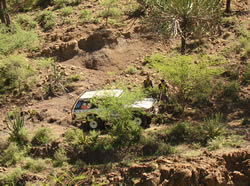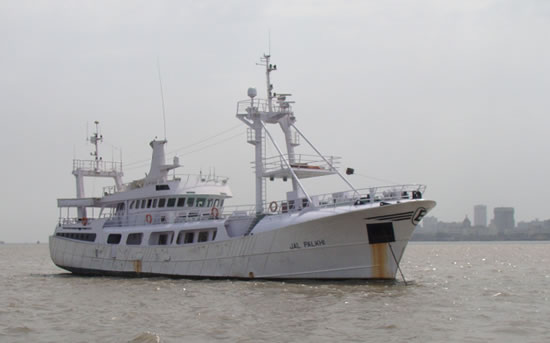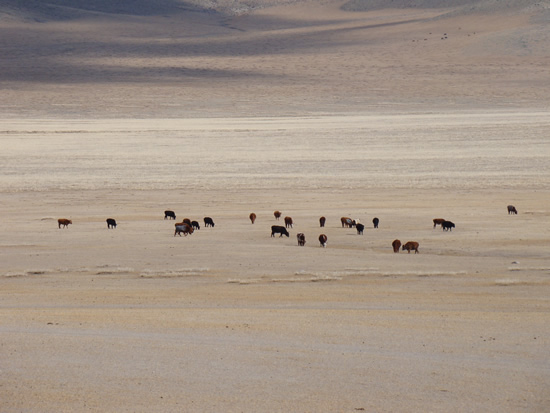One of the great things about traveling is to sample the regional cuisine, and then, for a bit of fun, (and a bit of a hit or miss affair) occasionally sample the local take on another cultures food. With that in mind I was taken to one of the best Muslim restaurants in Bombay, the Delhi Durval, just opposite the Leopold’s Café. Apart from having a great menu, its also culturally interesting – entire Muslim families, old men with beards dyed bright orange, and where you get to see how a woman clad from head to toe in hijab, gets to eat. All that aside, the quality of the local menu is superb – plenty of lamb of course, but no pork and no alcohol. Feeling adventurous, we tucked into the sheep brains masala (the brains were creamy and tasted a little like cottage cheese) and the lamb’s trotters. Thinking about the latter, as little trotters were served in a delicious, tangy sauce with tomato and coriander, this must be a dish for the wealthy. Lambs grow up into sheep, and are productive in wool and dairy products, eating them therefore is the height of decadence. There’s not much meat on a lamb’s trotter, mainly a bit of skin and gelatine (which is fine) but the delight is saved for last – the age old ritual of bone marrow sucking. It all felt rather Biblical, and I’m sure tales of marrow munching occur in the Koran as well. Abraham would have recognized the ritual. Then, full of Islamic sheep, I spotted the restaurants alternative menu – and it was Chinese. I took a good look to ascertain the authenticity, and actually, the internationally traveled “vegetable spring rolls” were all present and correct, as were “Sliced Chicken in Schezwan Sauce”, “Chicken Lung Fung Soup” and Vegetable, Mushroom and Bamboo Shoots”. But even these, apparently standard Chinese dishes reveal both the complexity of China, and of China’s perception by the rest of the world, and old habits die hard. Chinese restaurants will note “Sichuan” Sauce, not “Schezwan”, the latter being based on the Wade-Giles system of romanization of Chinese characters invented in 1892, pre-dating the current pinyin system which was actually adopted by the Chinese government in 1952. Overseas Chinese restaurants still often (and charmingly in my view) use the Wade-Giles system, demonstrating that old habits die hard – it is more than 50 years out of date, and demonstrates just how old the Chinese overseas diaspora – most of whom still use Wade-Giles – is. Then, “Lung Fung” is Cantonese, from Hong Kong, basically translating as “Wind of Dragon”. Quite what effect that would have as a soup on ones digestive system I cannot imagine. The menu goes on to specify “Vegetable Hakka Chow Mein” – with the Hakka being a Southern Chinese people, inhabiting the coasts of Fujian and Guangdong, and “Chicken Manchow” – a reference to the Manchu, who were the ruling class in China until 1912. The Chinese menu therefore, has become a sort of time capsule in which both language and food have been handed down as they were from 50 —100 years ago. That’s quite impressive, and makes the menu itself rather enjoyable.
(more…)

 I’ve been in Kenya, near to Lake Baringo, the past week to participate in the annual Rhino Charge which takes place each year at different locations throuighout the country. Theevent, now in it’s 21st year, is designed to raise money to build a 400km fence in the Aberdare Conservation area – to keep Rhino and other animals in, and poachers and encroaching tribes out. THis years event marked the completion of enough funds to complete the fence. Vehicles – mainly Land Rovers, Land Cruisers and Unimogs, compete over a gruelling course, comprising 13 stations. Each team must visit all stations over a period of eight hours, in the shortest possible distance. Terrain ranges from teetering alongside 400 foot drops, to clambering and winching over huge boulders, to crashing through the bush.
I’ve been in Kenya, near to Lake Baringo, the past week to participate in the annual Rhino Charge which takes place each year at different locations throuighout the country. Theevent, now in it’s 21st year, is designed to raise money to build a 400km fence in the Aberdare Conservation area – to keep Rhino and other animals in, and poachers and encroaching tribes out. THis years event marked the completion of enough funds to complete the fence. Vehicles – mainly Land Rovers, Land Cruisers and Unimogs, compete over a gruelling course, comprising 13 stations. Each team must visit all stations over a period of eight hours, in the shortest possible distance. Terrain ranges from teetering alongside 400 foot drops, to clambering and winching over huge boulders, to crashing through the bush. Today (May 8th) is my birthday, so what better subject to provide to recognize that than a bottle of French wine? No ordinary wine either – I discovered it at the ridiculous price of USD8 in a local store in Beijing, which pleased me no end, and noticed the “Depuis 1531” slogan on it. Since 1531? Wow. Interest piqued and taste buds at the ready, I both opened the bottle – it’s certainly a productive cork that zooms out – and imbibed. Pears, mainly, but creamy and naturally sparkling. Definitely worth eight bucks. It turns out that Bulle de Blanquette has been made in the region of Limoux in Central France since 1531, with the Monks of St. Hilaire being responsible. They invented the process, some 150 years before Champagne was recorded. It’s also interesting to note that Dom Perignon, an esteemed Monk himself, stayed in the region before leaving to travel to Epernay and begin making methode champenoise there. It was the St. Hilaire Monks who first tied corks to the bottles to prevent the bubbles exploding, and they still follow tradition and bottle at the time of the full moon in March ready for the warmer weather to start the secondary fermentation that produces les bulles (the bubbles). All the grapes for Blanquette have to be harvested by hand into small boxes to prevent bruising, and the regulations also limit the yield to ensure a quality product. Growers who can produce and market Blanquette are limited to a set area of 41 villages around the 2000 year old town of Limoux.
Today (May 8th) is my birthday, so what better subject to provide to recognize that than a bottle of French wine? No ordinary wine either – I discovered it at the ridiculous price of USD8 in a local store in Beijing, which pleased me no end, and noticed the “Depuis 1531” slogan on it. Since 1531? Wow. Interest piqued and taste buds at the ready, I both opened the bottle – it’s certainly a productive cork that zooms out – and imbibed. Pears, mainly, but creamy and naturally sparkling. Definitely worth eight bucks. It turns out that Bulle de Blanquette has been made in the region of Limoux in Central France since 1531, with the Monks of St. Hilaire being responsible. They invented the process, some 150 years before Champagne was recorded. It’s also interesting to note that Dom Perignon, an esteemed Monk himself, stayed in the region before leaving to travel to Epernay and begin making methode champenoise there. It was the St. Hilaire Monks who first tied corks to the bottles to prevent the bubbles exploding, and they still follow tradition and bottle at the time of the full moon in March ready for the warmer weather to start the secondary fermentation that produces les bulles (the bubbles). All the grapes for Blanquette have to be harvested by hand into small boxes to prevent bruising, and the regulations also limit the yield to ensure a quality product. Growers who can produce and market Blanquette are limited to a set area of 41 villages around the 2000 year old town of Limoux.



